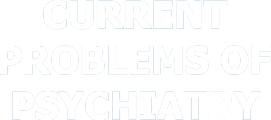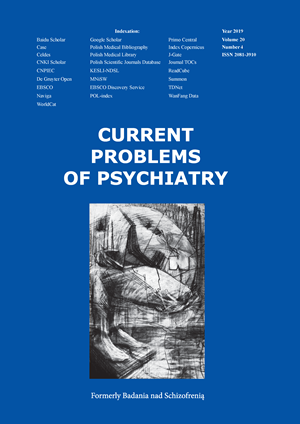Obraz siebie oraz wybrane zmienne kliniczne w kontekście przemocy doznawanej w dzieciństwie u osób z zespołem uzależnienia od alkoholu
DOI:
https://doi.org/10.2478/cpp-2019-0016Słowa kluczowe:
uzależnienie od alkoholu, zaburzenia używania alkoholu, przemoc w dzieciństwie, obraz siebie, samobójstwo, samouszkodzeniaAbstrakt
Cel: Celem badania było określenie różnic w zakresie wybranych zmiennych klinicznych oraz obrazu siebie u osób uzależnionych od alkoholu różniących się nasileniem przemocy fizycznej, emocjonalnej i seksualnej doświadczanej przed 18 rokiem życia.
Metoda: Badaniem objęto 90 osób uzależnionych od alkoholu leczonych w całodobowym oddziale odwykowym. Zastosowano następujące narzędzia badawcze: Kwestionariusz Wczesnej Traumy -EDI, Test Przymiotnikowy ACL, test MAST, SAAD, oraz kwestionariusz własnej konstrukcji. W celu wyodrębnienia grup różniących się wysokością nasileniem nadużyć fizycznych, emocjonalnych i seksualnych w dzieciństwie zastosowano metodą analizy skupień.
Wyniki: Wyodrębniono dwie grupy osób uzależnionych od alkoholu: Grupę 1 z wysokimi indeksami nadużyć fizycznych, emocjonalnych i seksualnych w dzieciństwie oraz Grupę 2 z niskimi indeksami. W zakresie obrazu siebie badani z Grupy 1 w porównaniu do badanych z Grupy 2 charakteryzowali się niższą samooceną, niższym poziomem samoakceptacji, mniejszą odpornością na stres, mniejszą potrzebą porządku, wytrwałości, osiągnięć, kontaktów heteroseksualnych, podporządkowania oraz większą potrzebą zmiany. Badani z większym nasileniem przemocy w dzieciństwie charakteryzowali się niższym wiekiem inicjacji alkoholowej i początku systematycznego picia alkoholu, większym nasileniem uzależnienia od alkoholu, częstszym występowaniem dziedzicznego obciążenia uzależnieniem od alkoholu, prób samobójczych, myśli samobójczych oraz samouszkodzeń w przeszłości.
Dyskusja: Otrzymane wyniki ściśle korespondują z danymi dostępnymi w literaturze.
Wnioski: Ocena narażenia na różne formy przemocy w dzieciństwie wydaje się być nieodzownym elementem zbierania wywiadu chorobowego od osób uzależnionych od alkoholu.
Bibliografia
1. Jarosz E. Dom, który krzywdzi. Katowice; „ Śląsk” Wydawnictwo Naukowe :2001.
2. Scher CD, Forde DR, Mc Quaid JR, Stein MB. Prevalence and demographic correlates of childhood maltreatment in an adult community sample. Child Abuse Negl.2004; 28(2):167-80.10 https://doi.org/1016/j.chiabu.2003.09.012
3. Bernstein DP, Stein JA, Handelsman L. Predicting personality pathology among adult patients with substance use disorders: Effects of childhood maltreatment. Addict Behav. 1998;23(6):855-68 https://doi.org/10.1016/S0306-4603(98)00072-0
4. Huang MC, Schwandt ML, Ramchandani VA, George DT, Heilig M. Impact of multiple types of childhood trauma exposure on risk of psychiatric comorbidity among alcoholic inpatients. Alcohol Clin Exp Res. 2012; 36(6):1099-107 https://doi.org/10.1111/j.1530-0277.2011.01695.x
5. Potthast N, Neuner F, Catani C. The contribution of emotional maltreatment to alcohol dependence in a treatment-seeking sample. Addict Behav. 2014; 39(5): 949-58 https://doi.org/10.1016/j.addbeh.2014.01.015
6. Anda RF, Felitti VJ, Bremner JD, Walker JD, Whitfield CH, Perry BD et all. The enduring effects of abuse and related adverse experiences in childhood. Eur Arch Psychiatry Clin Neurosci. 2006; 256(3):174-86 https://doi.org/10.1007/s00406-005-0624-4
7. Dube SR., Anda R.F., Felitti V.J., Edwards V.J., Croft J.B. Adverse childhood experiences and personal alcohol abuse as an adult. Addict Behav.2002; 27 (5):713–25 https://doi.org/10.1016/S0306-4603(01)00204-0
8. Fenton MC, Geier T, Keyes K, Skodol AE, Grant BF, Hasin DS. Combined role of childhood maltreatment, family history, and gender in the risk for alcohol dependence. Psychol Med. 2013;43(05):1045-57 https://doi.org/10.1017/S0033291712001729
9. Cibor R. Struktura „Ja” a motywy podejmowania leczenia odwykowego. Katowice; Wydawnictwo Uniwersytetu Śląskiego:1994.
10. Gross WF, Alder LO. Aspects of alcoholic’s self-concepts as measured by the Tennessee Self-Concept Scale. Psychological Reports. 1970;27(2):431-4. https://doi.org/10.2466/pr0.1970.27.2.431
11. Kulpa A. Obraz samego siebie u osób z zespołem zależności alkoholowej. Problemy Alkoholizmu 1982;6 :9-10.
12. Brosowska W. Samoocena a przystosowanie społeczne u nałogowych alkoholików. Problemy Alkoholizmu. 1984;7-8:32-33
13. Nikodemska S. Struktura ja, obraz siebie i radzenie sobie w sytuacji trudnej u pacjentów lecznictwa odwykowego. Świat Problemów. 2003;10: 4-7
14. Szczukiewicz P. Osobowość nałogowa .Świat Problemów. 2004;3:14-17
15. Aubry C, Gay MC, Romo L, Joffre S. L’image de soi de l’alcoolodépendant à travers l’échelle Tennessee du concept de soi. Encephale.2004; 30(1):24-31. https://doi.org/10.1016/S0013-7006(04)95412-7
16. Lopez MA, Heffer RW. Self-concept and social competence of university student victims of childhood physical abuse. Child Abuse Negl.1998;22(3):183-95. https://doi.org/10.1016/S0145-2134(97)00136-1
17. Giant CL,Vartanian LR. Experiences with parental aggression during childhood and self-concept in adulthood: The importance of subjective perceptions.J Fam Violence. 2003;18(6):361-7. https://doi.org/10.1023/A:1026253700293
18. Turner HA, Butler MJ. Direct and indirect effects of childhood adversity on depressive symptoms in young adults. J Youth Adolesc.2003;32(2):89-103. https://doi.org/10.1023/A:1021853600645
19. Cavaiola AA, Schiff M. Self-esteem in abused chemically dependent adolescents. Child Abuse Negl. 1989;13(3):327-34. https://doi.org/10.1016/0145-2134(89)90072-0
20. Moran PB, Eckenrode J. Protective personality characteristics among adolescent victims of maltreatment. Child Abuse Negl. 1992;16(5):743-54. https://doi.org/10.1016/0145-2134(92)90111-4
21. Śpila B, Makara M, Chuchra M., Grzywa A. Polska adaptacja Inwentarza Wczesnej Traumy (ETI).Wiadomości Psychiatryczne. 2005;8(1):20-4.
22. Gerhant A, Olajossy M. Personality traits in alcohol-dependent individuals in the context of childhood abuse. Psychiatr Pol. 2016;50(5):973-987. https://doi.org/10.12740/PP/6034627992890
23. Matkowski M. Test Przymiotnikowy jako narzędzie do badania struktury potrzeb jednostki. Przegląd Psychologiczny.1984;17(2):519-36.
24. Selzer ML.The Michigan Alcoholism Screening Test (MAST): The quest for a new diagnostic instrument. Am J Psychiatry.1971;127:1653–58. https://doi.org/10.1176/ajp.127.12.16535565851
25. Falicki Z, Karczewski J, Wandzel L, Chrzanowski W. Usefulness of the Michigan Alcoho lism Screening Test (MAST) in Poland. Psychiatr Pol. 1989; 20:38–42.
26. Raistrick D, Dunbar G, Davidson R. Development of a questionnaire to measure alcohol dependence. Br J Addict. 1983;78(1):89-95. https://doi.org/10.1111/j.1360-0443.1983.tb02484.x6573181
27. Ziółkowski M. Ocena skuteczności farmakoterapii w zapobieganiu nawrotowi picia u mężczyzn uzależnionych od alkoholu: praca habilitacyjna. Bydgoszcz; Wydawnictwo Uczelniane AM :1999.
28. Beck AT, Wright FD, Newman CF, Liese BS. Cognitive Therapy of Substance Abuse.New York; The Guilford Press :1998.
29. Finkelhor D, Browne A. The traumatic impact of child sexual abuse: A conceptualization. A J Orthopsychiatry.1985;55(4):530-4110.1111/j.1939-0025.1985.tb02703.x4073225
30. Booth BM, Russell DW, Soucek S, Laughlin PR. Social support and outcome of alcoholism treatment: An exploratory analysis. Am J Drug Alcohol Abuse. 1992;18(1):87-101. https://doi.org/10.3109/009529992090016141562009
31. Groh DR, Jason LA, Keys CB. Social network variables in alcoholics anonymous: A literature review. Clin Psychol Rev. 2008;28(3):430-50. https://doi.org/10.1016/j.cpr.2007.07.014228987117719158
32. Rosen CS, Ouimette PC, Sheikh JI, Gregg JA, Moos RH. Physical and sexual abuse history and addiction treatment outcomes. J Stud Alcohol. 2002;63(6):683-7. https://doi.org/10.15288/jsa.2002.63.683
33. Bętkowska-Korpała B. Osobowość w Modelu Wielkiej Piątki a utrzymywanie abstynencji od alkoholu przez rok od rozpoczęcia leczenia. Psychiatr Pol.2012; 46(3):397-9.
34. Chung T, Langenbucher J, Labouvie E, Pandina RJ, Moos RH. Changes in alcoholic patients’ coping responses predict 12-month treatment outcomes. J Consult Clin Psychol .2001:69(1):92-100. https://doi.org/10.1037/0022-006X.69.1.92
35. Brems C, Namyniuk L. The relationship of childhood abuse history and substance use in an Alaska sample. Subst Use Misuse.2002;37(4):473-94. https://doi.org/10.1081/JA-120002806
36. Dube SR, Miller JW, Brown DW, Giles WH, Felitti VJ, Dong M, Anda RF. Adverse childhood experiences and the association with ever using alcohol and initiating alcohol use during adolescence. J Adolesc Health. 2006;38(4):444.e1-10. https://doi.org/10.1016/j.jadohealth.2005.06.006
37. Zlotnick C, Johnson DM, Stout RL, Zywiak WH, Johnson JE, Schneider RJ. Childhood abuse and intake severity in alcohol disorder patients. J Trauma Stress. 2006;19(6):949-59. https://doi.org/10.1002/jts.20177
38. Waldrop AE, Santa Ana EJ, Saladin ME, McRae AL, Brady KT. Differences in early onset alcohol use and heavy drinking among persons with childhood and adulthood trauma. Am J Addict. 2007;16(6):439-44. https://doi.org/10.1080/10550490701643484
39. Rothman EF, Edwards EM, Heeren T, Hingson RW.Adverse childhood experiences predict earlier age of drinking onset: results from a representative US sample of current or former drinkers. Pediatrics. 2008;22(2):298-304. https://doi.org/10.1542/peds.2007-3412
40. Miller BA, Mancuso RF. Connecting childhood victimization to later alcohol/drug problems: Implications for prevention. J Prim Prev.2004;25(2):149-69. https://doi.org/10.1023/B:JOPP.0000042387.04080.7b
41. Aranowska E, Chachaj L, Morawski J. Three versions of alcoholism: MAST, SADD, RDC. W: Piotrowski A, Leder S, Gawrońska B.red. Alcoholism and other Dependencies. Warszawa; Polish Psychiatric Association:1989:195-203.
42. Westermeyer J, Wahmanholm K, Thuras P. Effects of childhood physical abuse on course and severity of substance abuse. Am J Addict. 2001;10(2):101-10. https://doi.org/10.1080/105504901750227769
43. Liebschutz J, Savetsky JB, Saitz R, Horton NJ, Lloyd-Travaglini C, Samet JH. The relationship between sexual and physical abuse and substance abuse consequences. J Subst Abuse Treat. 2002;22(3):121-8. https://doi.org/10.1016/S0740-5472(02)00220-9
44. Anda RF, Whitfield CL, Felitti VJ, Chapman D, Edwards VJ, Dube SR, Williamson DF. Adverse childhood experiences, alcoholic parents, and later risk of alcoholism and depression. Psychiatr Serv. 2002;53(8):1001-9. https://doi.org/10.1176/appi.ps.53.8.100112161676
45. Fenton MC, Geier T, Keyes K, Skodol AE, Grant BF, Hasin DS. Combined role of childhood maltreatment, family history, and gender in the risk for alcohol dependence. Psychol Med. 2013;43(05):1045-57. https://doi.org/10.1017/S0033291712001729376741222883538
46. Kessler RC, Borges G, Walters EE. Prevalence of and risk factors for lifetime suicide attempts in the National Comorbidity Survey. Arch Gen Psychiatry.1999;56(7):617-26. https://doi.org/10.1001/archpsyc.56.7.61710401507
47. Wilcox HC, Conner KR, Caine ED. Association of alcohol and drug use disorders and completed suicide: an empirical review of cohort studies. Drug Alcohol Depend. 2004;76, Suppl:11-19.
48. Bácskai E, Czobor P, Gerevich J. Suicidality and trait aggression related to childhood victimization in patients with alcoholism. Psychiatry Res.2009;165(1):103-10. https://doi.org/10.1016/j.psychres.2007.11.01319038461
49. Roy A, Jana N. Risk factors for suicide attempts among alcohol dependent patients. Arch Suicide Res. 2007;11(2):211-17. https://doi.org/10.1080/1381111070125015017453699
50. Chodak M, Barwiński Ł. Autoagresja jako forma radzenia sobie ze stresem- przegląd zagadnień. Self-aggression as a form of coping with stress-a reviewof issues. Psychiatria i Psychoterapia 2010;6(1):19-30.
51. Briere J, Gil E. Self-mutilation in clinical and general population samples: prevalence, correlates, and functions. Am J Orthopsychiatry. 1998;68 (4):609–20. https://doi.org/10.1037/h00803699809120
52. Evren C, Sar V, Evren B, Dalbudak E. Self-mutilation among male patients with alcohol dependency: the role of dissociation. Compr. Psychiatry 2008; 9(5): 489-495. https://doi.org/10.1016/j.comppsych.2008.02.006
53. Evren C, Evren B. Self-mutilation in substance-dependent patients and relationship with childhood abuse and neglect, alexithymia and temperament and character dimensions of personality. Drug Alcohol Depend. 2005:80(1):15-22. https://doi.org/10.1016/j.drugalcdep.2005.03.01716157228
54. Evren C, Cınar O, Evren B, Celik S. Self-mutilative behaviors in male substance-dependent inpatients and relationship with anger and aggression: mediator effect of childhood trauma. Compr Psychiatry.2012;53(3):252-258. https://doi.org/10.1016/j.comppsych.2011.04.06121632037
Pobrania
Opublikowane
Numer
Dział
Licencja
Prawa autorskie (c) 2019 Autorzy

Praca jest udostępniana na licencji Creative Commons Attribution-NonCommercial-NoDerivatives 3.0 Unported License.


